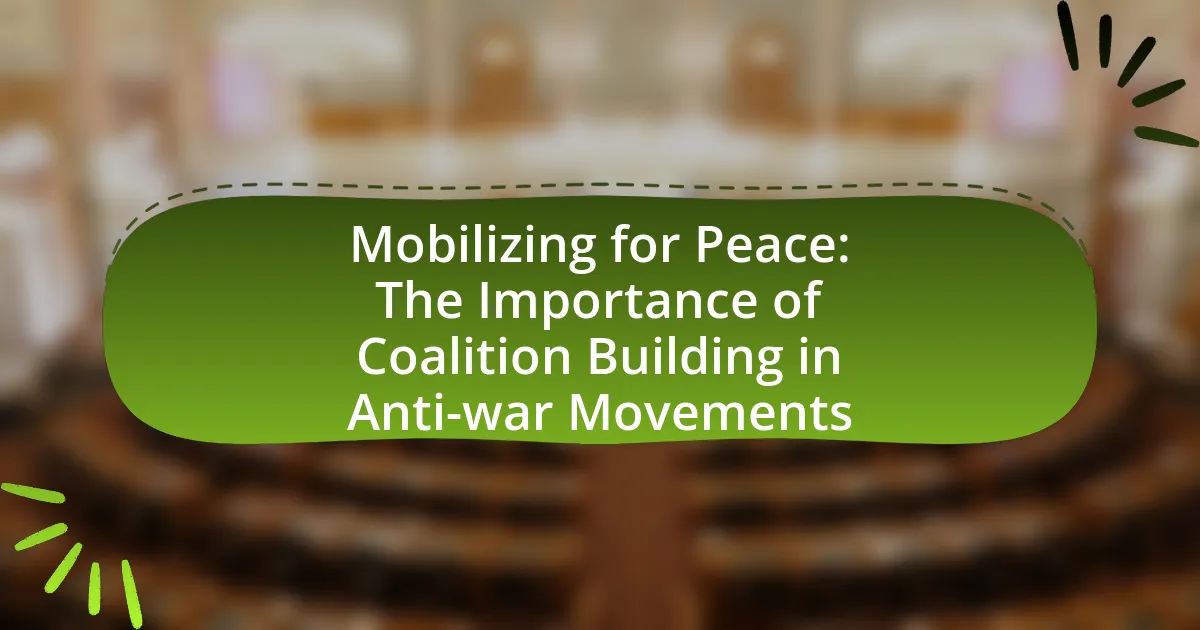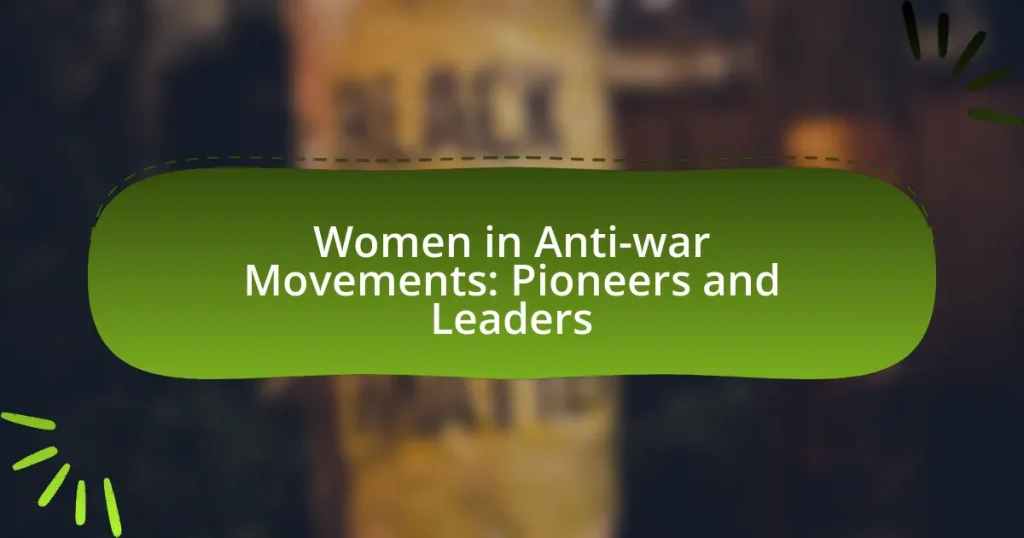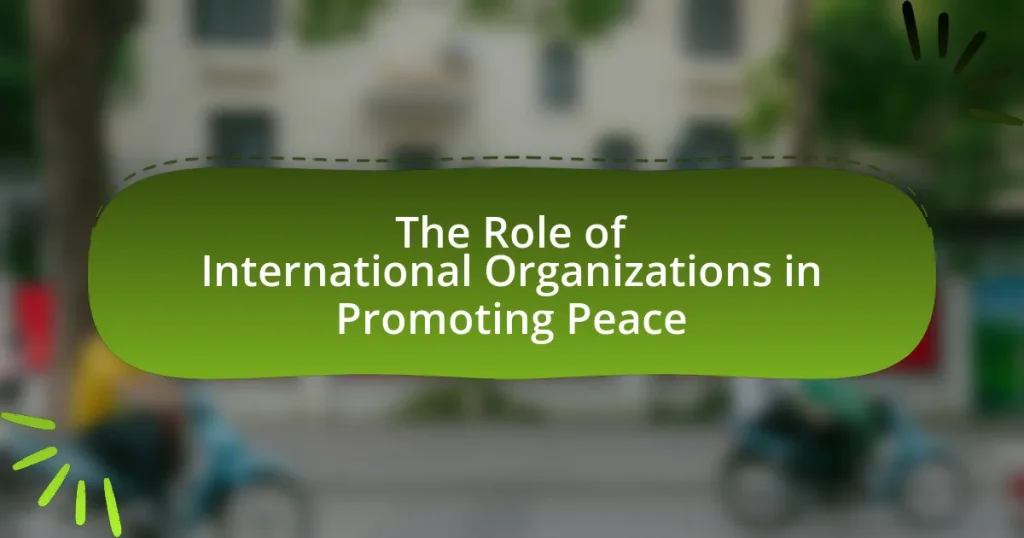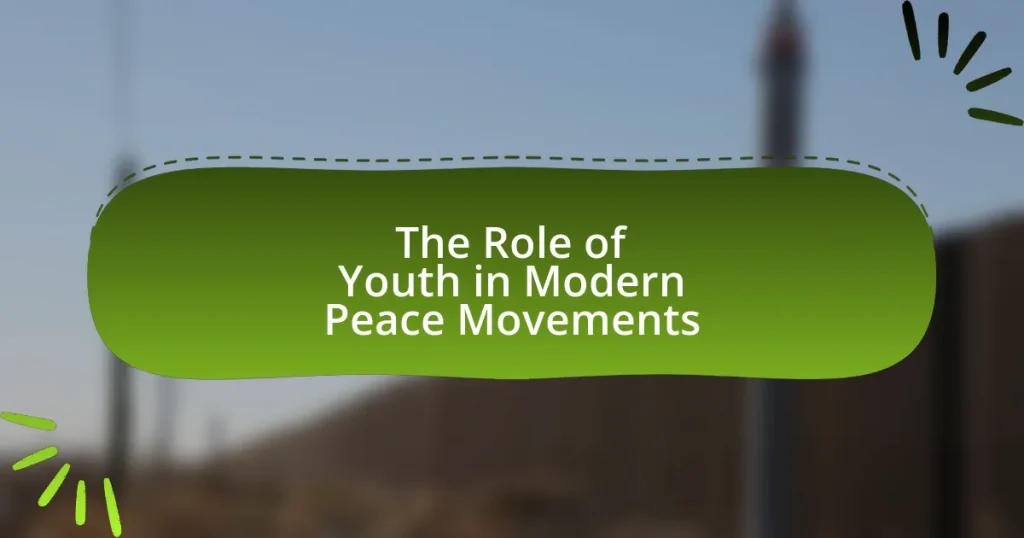The article focuses on the significance of coalition building in anti-war movements, emphasizing its role in uniting diverse groups to collectively oppose war and militarism. It outlines the essential principles of effective coalition building, such as shared goals, mutual respect, and inclusivity, which enhance the movement’s impact by pooling resources and amplifying voices. Historical examples, including the Vietnam War protests and the anti-apartheid movement, illustrate how strategic alliances can mobilize larger segments of the population and influence public policy. The article also addresses the challenges coalitions face, such as ideological differences and funding issues, while providing best practices for successful coalition formation and sustainability.
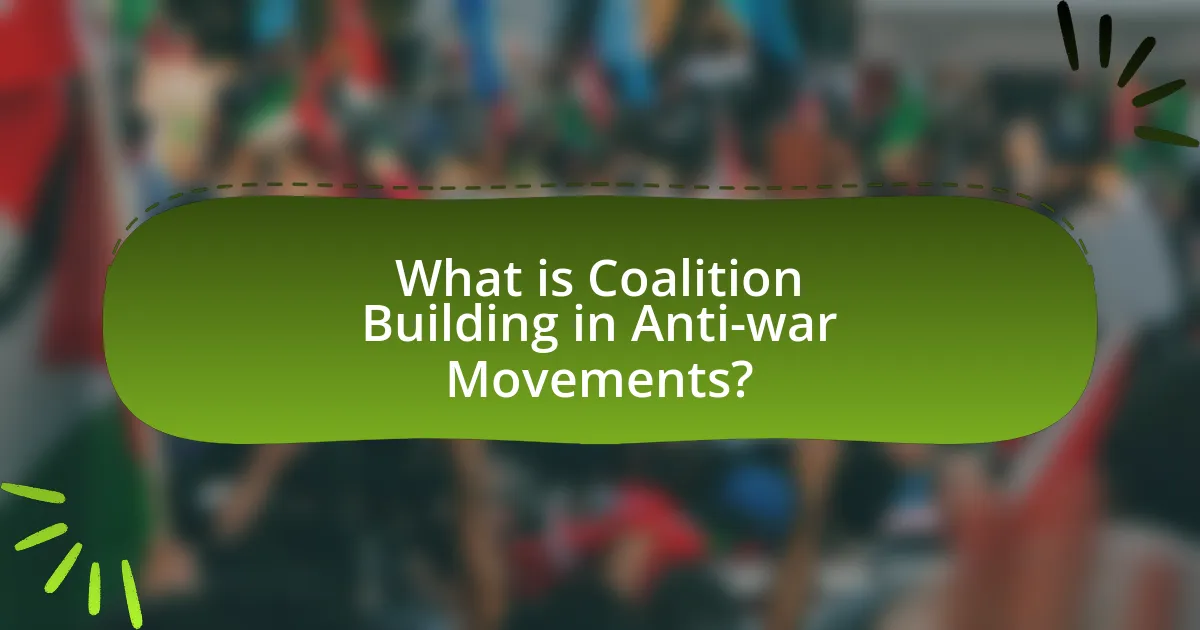
What is Coalition Building in Anti-war Movements?
Coalition building in anti-war movements refers to the process of uniting diverse groups and individuals to collectively oppose war and militarism. This strategy enhances the effectiveness of the movement by pooling resources, amplifying voices, and fostering solidarity among various stakeholders, including peace organizations, social justice groups, and grassroots activists. Historical examples, such as the coalition formed during the Vietnam War, demonstrate that diverse alliances can mobilize larger segments of the population, leading to significant political pressure and policy changes.
Why is Coalition Building Essential for Mobilizing for Peace?
Coalition building is essential for mobilizing for peace because it unites diverse groups and amplifies their collective voice, increasing the effectiveness of anti-war movements. By bringing together various stakeholders—such as non-governmental organizations, community leaders, and grassroots activists—coalitions can pool resources, share knowledge, and coordinate actions, which enhances their ability to influence public opinion and policy. Historical examples, such as the coalition efforts during the Vietnam War, demonstrate that unified movements can significantly impact government decisions and public sentiment, leading to a greater likelihood of achieving peace.
What are the key principles of effective coalition building?
The key principles of effective coalition building include shared goals, mutual respect, open communication, and inclusivity. Shared goals ensure that all members are aligned in their objectives, which fosters unity and purpose. Mutual respect among diverse groups enhances collaboration and trust, essential for a successful coalition. Open communication facilitates transparency and allows for the exchange of ideas, which is critical for problem-solving and decision-making. Inclusivity ensures that all voices are heard, particularly those from marginalized communities, which strengthens the coalition’s legitimacy and effectiveness. These principles are supported by research indicating that coalitions with clear, shared objectives and strong interpersonal relationships are more likely to achieve their aims in social movements, including anti-war efforts.
How does coalition building enhance the impact of anti-war movements?
Coalition building enhances the impact of anti-war movements by uniting diverse groups to amplify their collective voice and resources. This unity allows for a broader representation of perspectives, increasing public engagement and awareness. For instance, the 2003 anti-Iraq War protests saw participation from various organizations, including labor unions, religious groups, and environmental activists, which collectively mobilized millions globally, demonstrating a significant increase in visibility and influence compared to isolated efforts. Such coalitions can also pool financial and logistical resources, enabling more effective campaigns and outreach.
What Historical Examples Illustrate Successful Coalition Building?
Successful coalition building is exemplified by the anti-apartheid movement in South Africa, which united various groups, including the African National Congress (ANC), trade unions, and international allies, to dismantle apartheid. This coalition effectively mobilized diverse sectors of society, leading to significant global pressure on the South African government. The movement’s success is evidenced by the 1994 democratic elections, which marked the end of apartheid and the election of Nelson Mandela as the first Black president. Another notable example is the United Farm Workers (UFW) coalition in the United States during the 1960s, which brought together labor unions, civil rights organizations, and community groups to advocate for the rights of farmworkers, resulting in improved labor conditions and the establishment of collective bargaining rights. These historical instances demonstrate how strategic alliances can amplify voices and achieve substantial social and political change.
How did the Vietnam War protests utilize coalition building?
The Vietnam War protests utilized coalition building by uniting diverse groups, including students, civil rights activists, and religious organizations, to amplify their collective voice against the war. This strategic collaboration allowed for a broader base of support, which was crucial in organizing large-scale demonstrations, such as the 1969 Moratorium to End the War in Vietnam, where over two million people participated nationwide. The effectiveness of coalition building is evidenced by the formation of groups like the National Mobilization Committee to End the War in Vietnam, which coordinated efforts across various demographics and ideologies, demonstrating that a united front could exert significant political pressure on the government.
What lessons can be learned from the Gulf War anti-war coalitions?
The Gulf War anti-war coalitions demonstrate the effectiveness of diverse alliances in mobilizing public opinion against military intervention. These coalitions included various groups, such as peace organizations, religious institutions, and labor unions, which collectively amplified their message and reached a broader audience. For instance, the coalition’s ability to unite different demographics and ideologies showcased the importance of inclusivity in advocacy efforts. Additionally, the use of grassroots organizing and nonviolent protest strategies proved essential in raising awareness and influencing political discourse. The coalition’s impact was evident in the significant public opposition to the war, as reflected in large-scale protests and opinion polls indicating widespread dissent. These lessons highlight that successful anti-war movements can thrive through strategic coalition-building, emphasizing unity and shared goals among diverse groups.
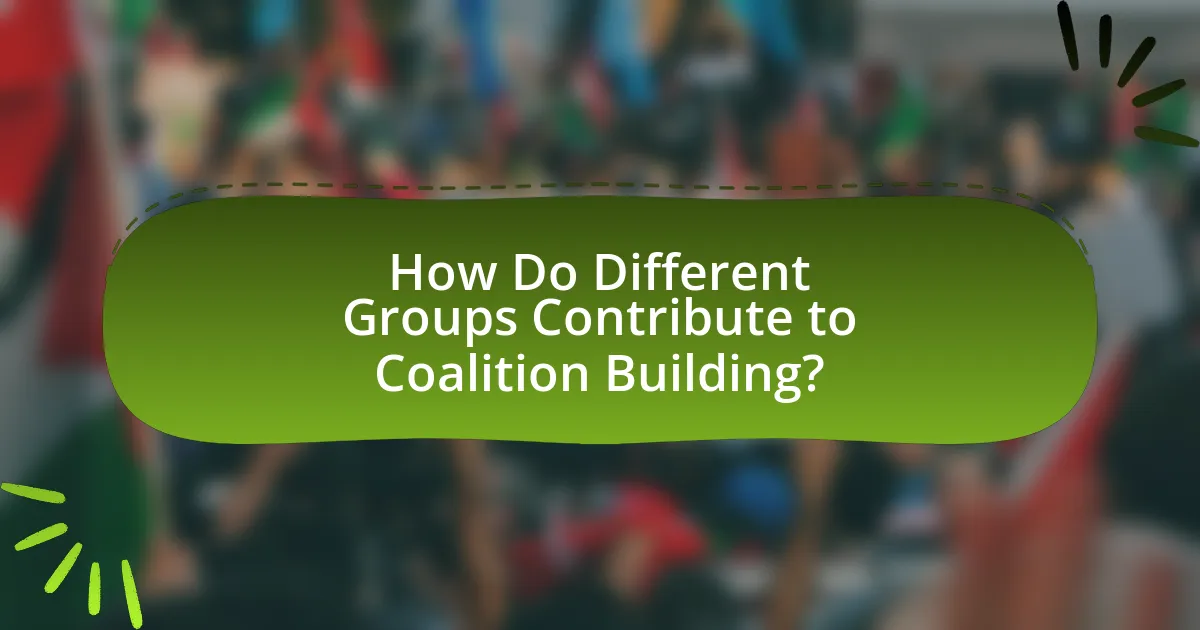
How Do Different Groups Contribute to Coalition Building?
Different groups contribute to coalition building by bringing diverse perspectives, resources, and networks that enhance collective action. For instance, grassroots organizations mobilize local communities, while larger NGOs provide funding and expertise. Academic institutions contribute research and data that inform strategies, and political groups can leverage their influence to advocate for policy changes. This multifaceted collaboration strengthens the coalition’s ability to address complex issues effectively, as evidenced by the success of the United for Peace and Justice coalition, which united over 1,400 organizations to oppose the Iraq War, demonstrating the power of diverse group contributions in achieving common goals.
What Roles Do Various Organizations Play in Anti-war Coalitions?
Various organizations play critical roles in anti-war coalitions by providing resources, mobilizing grassroots support, and amplifying diverse voices. Non-governmental organizations (NGOs) often lead advocacy efforts, utilizing their networks to raise awareness and influence policy. Faith-based groups contribute moral authority and community engagement, while labor unions mobilize workers and emphasize the economic impacts of war. Academic institutions provide research and analysis, helping to frame the discourse around conflict. Historical examples, such as the Vietnam War protests, illustrate how these organizations collaborated to create a unified front, demonstrating the effectiveness of coalition building in achieving peace objectives.
How do grassroots organizations influence coalition dynamics?
Grassroots organizations significantly influence coalition dynamics by fostering inclusivity and amplifying diverse voices within movements. These organizations often serve as the foundation for mobilizing community members, which enhances the coalition’s ability to address a wider range of issues and perspectives. For instance, grassroots groups can effectively engage marginalized populations, ensuring that their concerns are represented in coalition discussions and strategies. This inclusivity not only strengthens the coalition’s legitimacy but also increases its capacity to mobilize larger numbers of participants, as seen in various anti-war movements where grassroots efforts have led to substantial public demonstrations and advocacy campaigns. Research indicates that coalitions with strong grassroots involvement tend to be more resilient and adaptable, as they draw on local knowledge and networks to respond to changing circumstances and challenges.
What is the significance of academic and research institutions in coalition efforts?
Academic and research institutions play a crucial role in coalition efforts by providing evidence-based knowledge, fostering innovation, and facilitating interdisciplinary collaboration. These institutions contribute to the development of strategies and policies that address complex social issues, such as war and peace, by conducting rigorous research that informs coalition activities. For instance, studies from institutions like the University of California, Berkeley, have demonstrated how academic research can shape public discourse and influence policy decisions in anti-war movements. Additionally, academic institutions often serve as neutral grounds for dialogue, bringing together diverse stakeholders to collaborate on solutions, thereby enhancing the effectiveness of coalition efforts.
How Can Diverse Perspectives Strengthen Coalition Efforts?
Diverse perspectives can strengthen coalition efforts by fostering innovative solutions and enhancing problem-solving capabilities. When individuals from various backgrounds collaborate, they bring unique experiences and viewpoints that can identify blind spots and challenge assumptions, leading to more comprehensive strategies. Research indicates that diverse teams are 35% more likely to outperform their homogeneous counterparts in decision-making processes, as highlighted in a study by McKinsey & Company. This diversity not only enriches discussions but also increases the coalition’s ability to resonate with a broader audience, ultimately enhancing its effectiveness in mobilizing for peace in anti-war movements.
What are the benefits of including marginalized voices in anti-war movements?
Including marginalized voices in anti-war movements enhances the effectiveness and inclusivity of these initiatives. Marginalized groups often experience the direct consequences of war, providing unique perspectives that highlight the human cost of conflict. For instance, women, people of color, and economically disadvantaged communities frequently bear the brunt of violence and displacement, making their insights crucial for a comprehensive understanding of war’s impact. Research shows that movements that incorporate diverse voices are more likely to mobilize broader support and create sustainable change, as evidenced by the success of coalitions like the Women’s March, which united various marginalized groups to advocate for peace and justice. By amplifying these voices, anti-war movements can foster solidarity, challenge systemic inequalities, and promote a more equitable approach to peacebuilding.
How does intersectionality enhance coalition building?
Intersectionality enhances coalition building by recognizing and addressing the diverse identities and experiences of individuals within social movements. This approach fosters inclusivity, allowing various marginalized groups to collaborate effectively by understanding how overlapping social identities—such as race, gender, class, and sexuality—impact their experiences and struggles. For instance, the Women’s March in 2017 exemplified intersectionality by uniting various feminist perspectives, which strengthened the movement’s reach and effectiveness. By acknowledging these complexities, coalitions can create more comprehensive strategies that resonate with a broader audience, ultimately leading to more robust and sustainable movements for peace and social justice.
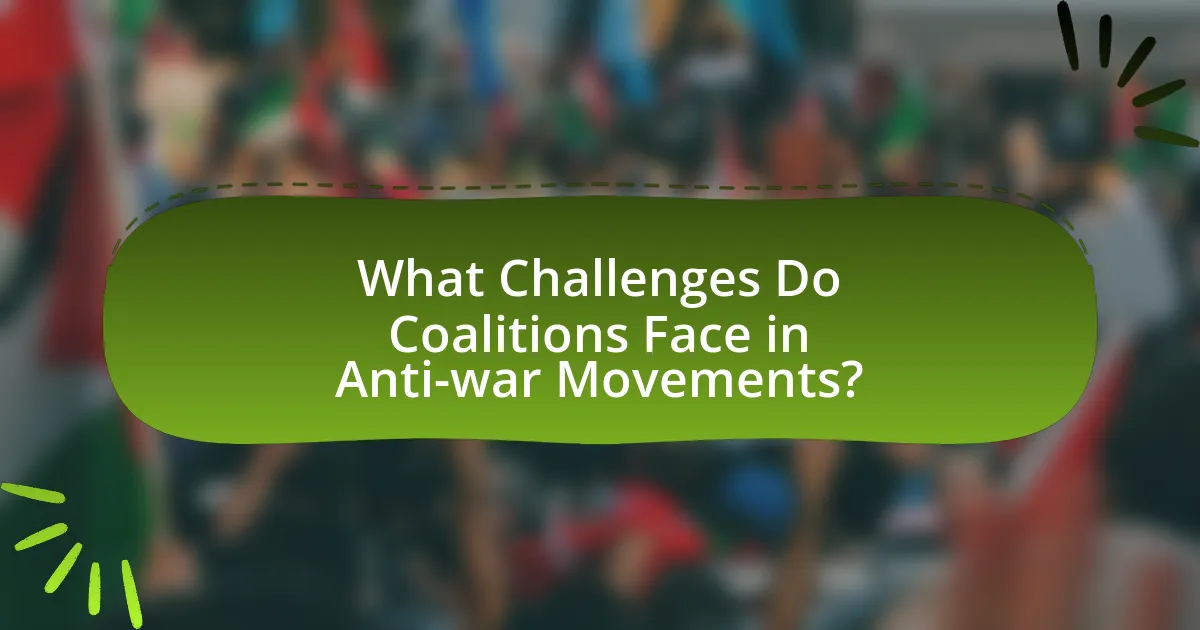
What Challenges Do Coalitions Face in Anti-war Movements?
Coalitions in anti-war movements face significant challenges such as ideological differences, resource allocation, and maintaining unity among diverse groups. Ideological differences can lead to conflicts over goals and strategies, making it difficult to present a cohesive front. For instance, groups may prioritize various issues like human rights, environmental concerns, or military spending, which can dilute the movement’s focus. Resource allocation challenges arise from limited funding and volunteer support, impacting the coalition’s ability to organize events and campaigns effectively. Additionally, maintaining unity is crucial; factions within coalitions may struggle with differing priorities or methods, which can weaken overall effectiveness. Historical examples, such as the Vietnam War protests, illustrate how these challenges can hinder coalition efforts, as various groups often splintered over differing views on the war and its implications.
What Common Obstacles Hinder Effective Coalition Building?
Common obstacles that hinder effective coalition building include differing priorities among stakeholders, lack of trust, and inadequate communication. Differing priorities can lead to conflicts over goals and strategies, making it difficult for groups to unite. Lack of trust among coalition members can result from past experiences or perceived inequities, which can undermine collaboration. Inadequate communication can create misunderstandings and limit the sharing of resources and information, further complicating coalition efforts. Research by the National Council of Nonprofits highlights that these factors significantly impact the success of collaborative initiatives, emphasizing the need for clear communication and alignment of goals to overcome these challenges.
How do differing agendas among coalition members create conflict?
Differing agendas among coalition members create conflict by leading to misaligned goals and priorities, which can result in competition for resources and influence. When coalition members have distinct objectives, such as varying approaches to peace or differing views on military intervention, these discrepancies can create friction and hinder collaborative efforts. For instance, a coalition focused on immediate ceasefire may clash with members advocating for long-term political solutions, causing divisions that weaken the overall effectiveness of the movement. Historical examples, such as the fragmentation seen in the anti-Vietnam War movement, illustrate how conflicting agendas can lead to reduced unity and effectiveness in achieving common goals.
What role does funding play in the sustainability of coalitions?
Funding is crucial for the sustainability of coalitions as it provides the necessary resources for operations, outreach, and advocacy efforts. Without adequate financial support, coalitions struggle to maintain their activities, engage members, and implement strategic initiatives. For instance, research indicates that coalitions with stable funding sources are more likely to achieve their goals and sustain their efforts over time, as they can invest in capacity building, communication, and mobilization activities. Furthermore, studies show that coalitions reliant on diverse funding streams, such as grants, donations, and partnerships, tend to be more resilient and adaptable to changing circumstances, thereby enhancing their long-term viability.
How Can Coalitions Overcome These Challenges?
Coalitions can overcome challenges by fostering strong communication and collaboration among diverse groups. Effective communication ensures that all members understand shared goals and strategies, which is crucial for maintaining unity. Additionally, establishing clear roles and responsibilities helps to streamline efforts and reduce conflicts. Research indicates that coalitions with well-defined structures and regular feedback mechanisms are more successful in achieving their objectives. For instance, the Coalition for Peace Action successfully mobilized various organizations by implementing regular meetings and collaborative planning sessions, which enhanced their collective impact in anti-war initiatives.
What strategies can be employed to resolve conflicts within coalitions?
To resolve conflicts within coalitions, strategies such as open communication, mediation, and establishing common goals can be employed. Open communication fosters transparency and trust among coalition members, allowing for the expression of differing viewpoints and concerns. Mediation involves a neutral third party facilitating discussions to help parties reach a consensus, which can be particularly effective in addressing deep-seated issues. Establishing common goals aligns the coalition’s members towards a shared purpose, reducing the likelihood of conflicts arising from divergent interests. These strategies are supported by research indicating that effective conflict resolution mechanisms enhance coalition stability and effectiveness, as seen in various anti-war movements where collaboration is essential for success.
How can coalitions secure sustainable funding for their initiatives?
Coalitions can secure sustainable funding for their initiatives by diversifying their funding sources and establishing strong partnerships with various stakeholders. By engaging with government agencies, private foundations, and corporate sponsors, coalitions can create a multi-faceted funding strategy that reduces reliance on a single source. For example, research from the National Council of Nonprofits indicates that organizations with diverse funding streams are more resilient and better positioned to weather financial challenges. Additionally, coalitions can enhance their funding prospects by demonstrating measurable impact and aligning their initiatives with the priorities of potential funders, thereby increasing their appeal and likelihood of receiving support.
What Best Practices Should Be Followed for Successful Coalition Building?
Successful coalition building requires clear communication, shared goals, and mutual respect among diverse stakeholders. Establishing open lines of communication ensures that all members understand the coalition’s objectives and can voice their perspectives. Shared goals create a unified vision, which is essential for collaboration; research indicates that coalitions with clearly defined objectives are more effective in achieving their aims. Mutual respect fosters trust and encourages participation, which is critical for sustaining engagement over time. Additionally, regular evaluation of coalition activities helps to adapt strategies and maintain alignment with the coalition’s mission.
How can effective communication enhance coalition collaboration?
Effective communication enhances coalition collaboration by fostering trust, clarity, and shared understanding among diverse groups. When coalition members communicate effectively, they can articulate their goals, share resources, and align their strategies, which is crucial for coordinated action. Research indicates that coalitions with strong communication practices are more likely to achieve their objectives, as evidenced by the success of the Coalition for Peace Action, which utilized clear messaging to unite various anti-war organizations and mobilize large-scale protests. This demonstrates that effective communication not only strengthens relationships but also amplifies the collective impact of coalition efforts.
What are the key steps in forming a successful anti-war coalition?
The key steps in forming a successful anti-war coalition include identifying common goals, building a diverse membership, establishing effective communication channels, and organizing strategic actions. Identifying common goals ensures that all members are united in their purpose, which is crucial for maintaining focus and momentum. Building a diverse membership brings together various perspectives and resources, enhancing the coalition’s strength and reach. Establishing effective communication channels facilitates collaboration and information sharing, which is essential for coordinated efforts. Organizing strategic actions, such as protests or awareness campaigns, mobilizes support and raises public consciousness about the anti-war message. Historical examples, such as the coalition formed during the Vietnam War, demonstrate that these steps lead to impactful movements that can influence public policy and opinion.
What Practical Tips Can Help Mobilize for Peace through Coalition Building?
To mobilize for peace through coalition building, organizations should prioritize clear communication and shared goals among diverse groups. Establishing a common vision fosters unity and encourages collaboration, as evidenced by the success of the Global Peace Index, which highlights the importance of cooperative efforts in reducing conflict. Additionally, leveraging social media platforms can enhance outreach and engagement, allowing coalitions to amplify their message and attract broader support. Research indicates that inclusive coalitions, which actively involve marginalized voices, are more effective in achieving sustainable peace outcomes.
